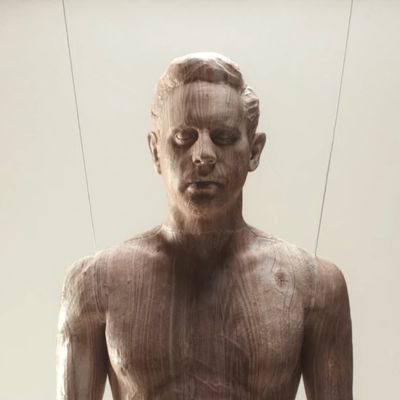
At the DGA Theater in midtown Manhattan last Thursday, stars graced the red carpet for the world premiere of The Politician, Ryan Murphy’s new political satire about an ambitious, cutthroat high schooler who aspires to one day become the president of the United States. Gwyneth Paltrow and Jessica Lange were there. So were January Jones and Bob Balaban. Lucy Boynton appeared with her boyfriend Rami Malek. And, of course, there was the show’s leading man, Tony-winning actor Ben Platt — alongside a life-size mannequin that looked just like him, a strange and dazzling effigy.
“It was like being at Burning Man,” laughs Heidi Berg, creative director with title design studio Elastic. “An enormous 3-D-printed version of Ben Platt — it seemed like we were going to set it on fire.” Berg and her creative co-director, Felix Soletic, dreamed up an enormous wooden sculpture of Platt as the centerpiece of The Politician’s mesmerizing opening title sequence, which imagines the hero of the series being put together piece by piece. Meticulously assembled and slickly tailored, the finished product is manufactured and manicured to perfection — an ideal presidential dummy, built from the ground up for the job. “We thought of it from the beginning as a person being artificially made,” Soletic explains. “He’s almost like a product to be sold later on.”
Berg and Soletic are veterans in the field of modern title design. Berg has worked on I Am the Night and The Alienist, while Soletic worked on Altered Carbon, Westworld, and The Crown. (Elastic, meanwhile, is one of the most popular and influential title design studios in the world, having done everything from Game of Thrones to True Detective, more or less setting the standard for prestige-TV title sequences in the process.) Both Berg and Soletic had worked with showrunner Ryan Murphy previously on his FX ballroom drama Pose, and were eager to collaborate with him again on The Politician. “Ryan always has a lot of ideas when he talks about opening title sequences, because he takes them seriously and loves them,” Berg says. In this case, though, he didn’t have anything specific in mind. He sent Berg and Soletic away with some scripts, and asked them to read, digest, and see how they were inspired.
“In the scripts, you got a sense early on that this character has sociopathic tendencies and lives life by collecting things — the right experiences, friendships, and relationships, all to make him the perfect presidential candidate,” Soletic says. “We abstracted those concepts into literal objects, and we compartmentalized them.” Berg and Soletic landed on the idea of building the character out of all the little things he hoards and fixates on: school pins and Dale Carnegie books, blank checks and prescription drugs. We see all this identity-forming stuff come together to make the man. “But it was also about what else we collect as humans,” Berg says. “We learn things. We have trauma. We collect these things and internalize them and they come to define us as human beings.”
In the title sequence, this bric-a-brac has a tactile, handcrafted quality, and it’s a lot more colorful and upbeat than other sequences of its kind, which tend to skew quite severe. That, too, was an intentional effort. “We like things dark and rimless and moody,” Soletic laughs. “We wanted to make this one bright, saturated, and to hint at the darkness metaphorically rather than stylistically.” The vivid colors and fussy arrangements are less Westworld and more Fantastic Mr. Fox. “We talked a lot about Wes Anderson,” Berg says. “We wanted that attention to detail, but also for it to be colorful and sarcastic, and to embrace that influence.” Soletic calls the look of it all “lived-in but precious.”
Once the menagerie of identifying objects has been assembled, the mannequin is shut and sealed and stood upright, at which point hands descend on the wooden body to sand and carve. Unlike the tiny objects, which are entirely digital, Berg and Soletic actually shot the woodworking with real hand models and tools. “This is why Felix and I work together so well,” Berg says. “He has a deep love of CG and I’m obsessed with shooting things. We wanted to find a way to merge these two languages. The carving you see is real. The sanding you see is real. And some moments, like the rubbing of the wood, is a mixture of CG and real hand-model work.” For Soletic, it was a matter of realism: “The subtlety of the wood grain and the dust that builds up, the way it splits open and carves — that level of nuance you just can’t replicate in CG.”
“We had people bringing their woodworking tools in from home,” Berg adds. “We learned so much from them. And actually, the tools you see in the sequence belonged to members of our team.”
Of course, the question of the moment is whether they really built a full-blown, life-size carving of Ben Platt. Sadly, they did not: The 3-D-printed replica whipped up for the premiere was the closest they came to seeing it realized. “We so desperately wanted to do a full carving,” Berg laments. “That was the goal. There was this German sculptor we were obsessed with and wanted to get. But there would have been no money left over for the actual titles.” Instead, they got creative: A production designer found a fiberglass mannequin to use for inserts, and they had a small chunk of upper torso carved to for tight close-ups in the woodworking scenes. “We did do a full-body 3-D scan of Ben Platt, though,” Solectic points out. “We have the CG mannequin of him and it pictured beautifully.”




